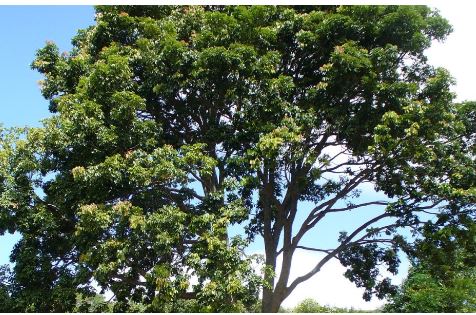
Mahogany is a straight-grained, reddish-brown timber of three tropical hardwood species of the genus Swietenia, indigenous to the Americas and part of the pantropical chinaberry family, Meliaceae. Mahogany has been one of the premier luxury timbers for centuries, used extensively in high-end furniture, musical instruments, boat building, and interior trim.
It is naturally found within the Americas, but has also been imported to plantations across Asia, Africa and Oceania. The mahogany trade may have begun as early as the 16th century and flourished in the 17th and 18th centuries. In certain countries, mahogany is considered an invasive species.
The tree can grow up to 40-60 meters (130-200 feet) tall, with a large, spreading canopy. It typically has a straight, cylindrical trunk with buttress roots in mature trees. It has moderate to fast, particularly in its youth and in favorable conditions. It can grow more than 1 meter per year in ideal settings. Mahogany trees can live for several centuries. Under good conditions, they might reach 350 years or more.
They have a broad, spreading canopy with dense foliage. The leaves are pinnate, usually with an even number of leaflets, giving them a fern-like appearance. Leaves are usually, glossy dark green above, lighter below. Small, white to greenish-yellow, appearing in panicles. They are not particularly showy but are fragrant, attracting pollinators like bees. Young trees have smooth, greyish bark which becomes dark brown, deeply fissured, and rough as the tree matures.
Characteristics of Mahogany Wood
- Color: The heartwood of mahogany varies from a pale pink or salmon color to a darker reddish-brown. Over time, with exposure to light, the color typically deepens.
- Grain: Generally straight, but can exhibit various attractive patterns like ribbon, fiddleback, or blister figures when quartersawn.
- Texture: Fine to medium texture with a natural luster.
- Durability: Known for its durability and resistance to rot, making it excellent for outdoor usage as well as indoor.
- Workability: Mahogany works well with both hand and machine tools, although its interlocked grain can sometimes cause issues during planing or molding.
Swietenia macrophylla – Big-Leaf Mahogany
- Also known as Honduran Mahogany, Brazilian Mahogany, or simply as True Mahogany.
- Distribution: Native to a broad range from Mexico through Central America to South America, including Brazil, Bolivia, and Peru.
- Characteristics: It has large leaves and can grow up to 40-60 meters tall. The wood is a light pink to dark reddish-brown color.
Swietenia mahagoni – Small-Leaf Mahogany or West Indian Mahogany
- Distribution: Native to southern Florida in the USA, the Bahamas, Cuba, Jamaica, and Hispaniola.
- Characteristics: Smaller leaves than S. macrophylla, and typically grows to about 20-25 meters in height. The wood tends to be darker and heavier than that of the big-leaf mahogany.
Swietenia humilis – Pacific Coast Mahogany
- Distribution: Found along the Pacific coast of Mexico.
- Characteristics: Smaller and less commercially important than the other species. It has been overharvested, leading to its rarity.
Khaya spp. – African Mahogany
- While not “true” mahogany like Swietenia, the Khaya genus includes several species that are referred to as African Mahogany.
- Common species include:
- Khaya senegalensis: Often used for its timber, which resembles true mahogany in quality.
- Khaya ivorensis: Another commonly harvested species for timber.
- Characteristics: They grow in various parts of Africa. The wood can vary but generally has a similar grain and color to true mahogany.
Entandrophragma cylindricum – Sapele
- Although not a Swietenia or Khaya, Sapele is often marketed as a type of mahogany due to its similar properties and appearance.
- Characteristics: Native to tropical Africa, it’s known for its lustrous iridescence and ribbon-stripe figuring when quarter-sawn.
Other Related Species
- There are other trees from different genera that might be called mahogany or have mahogany-like wood, such as:
- Shorea spp. – Philippine Mahogany (not true mahogany, includes species like Lauan, Meranti)
- Toona ciliata – Australian Red Cedar, which has been called mahogany in the past due to similar properties but is not related botanically.